Analysis of Risk, Concerns & Interventions in Mental Health Nursing
VerifiedAdded on 2022/10/09
|5
|1369
|15
Homework Assignment
AI Summary
This assignment analyzes a mental health case study, focusing on a client named Munny. It identifies an urgent risk of social isolation and proposes psychosocial interventions, including therapeutic communication, to address this risk, supported by relevant literature. A mental health concern of depression is identified, with group activities suggested as an intervention to alleviate low mood. The assignment further addresses legal and ethical considerations, emphasizing the importance of patient dignity, respect, and autonomy in care delivery, referencing the Mental Health Act and ethical guidelines. The student uses current literature to support all findings and recommendations.
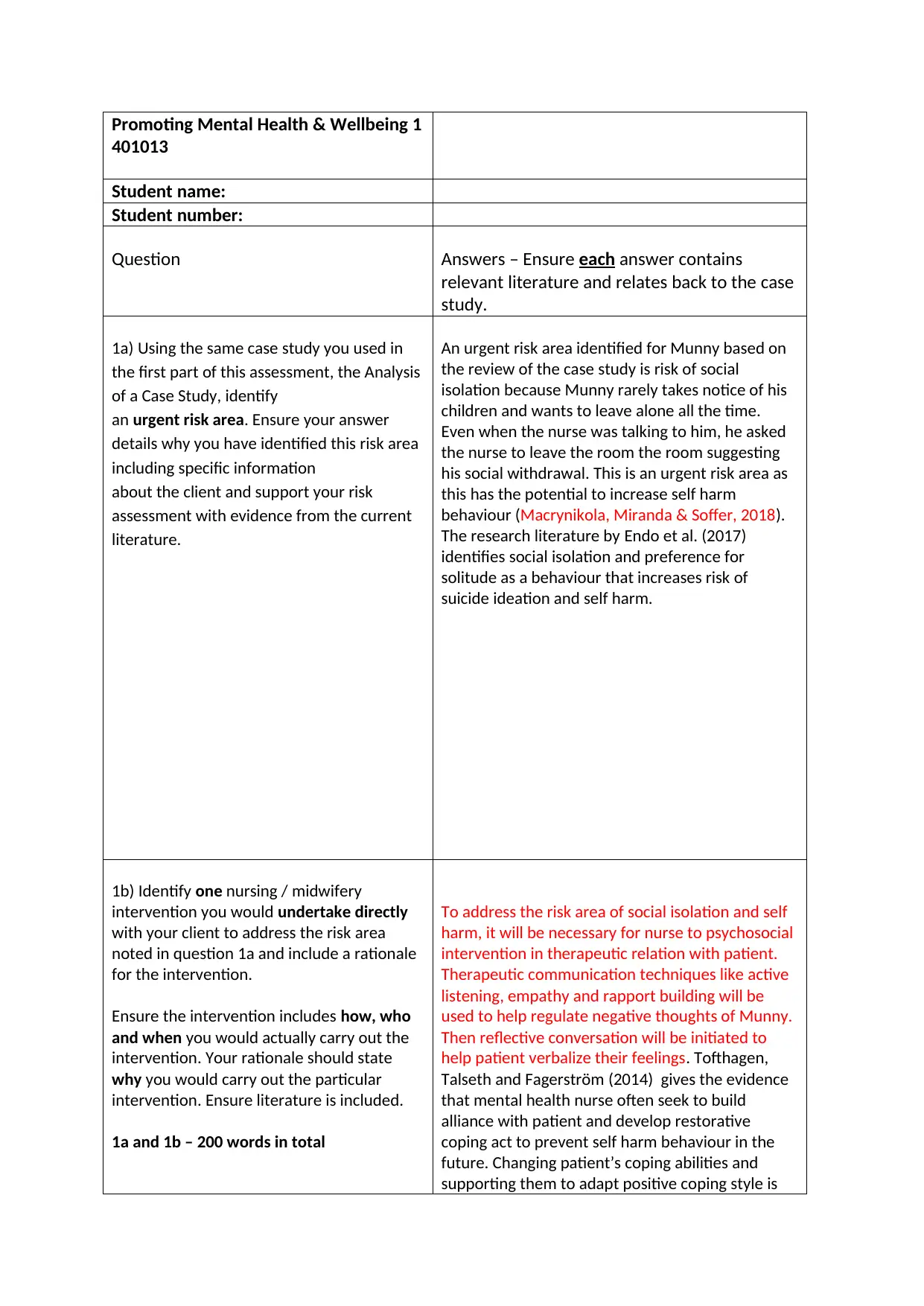
Promoting Mental Health & Wellbeing 1
401013
Student name:
Student number:
Question Answers – Ensure each answer contains
relevant literature and relates back to the case
study.
1a) Using the same case study you used in
the first part of this assessment, the Analysis
of a Case Study, identify
an urgent risk area. Ensure your answer
details why you have identified this risk area
including specific information
about the client and support your risk
assessment with evidence from the current
literature.
An urgent risk area identified for Munny based on
the review of the case study is risk of social
isolation because Munny rarely takes notice of his
children and wants to leave alone all the time.
Even when the nurse was talking to him, he asked
the nurse to leave the room the room suggesting
his social withdrawal. This is an urgent risk area as
this has the potential to increase self harm
behaviour (Macrynikola, Miranda & Soffer, 2018).
The research literature by Endo et al. (2017)
identifies social isolation and preference for
solitude as a behaviour that increases risk of
suicide ideation and self harm.
1b) Identify one nursing / midwifery
intervention you would undertake directly
with your client to address the risk area
noted in question 1a and include a rationale
for the intervention.
Ensure the intervention includes how, who
and when you would actually carry out the
intervention. Your rationale should state
why you would carry out the particular
intervention. Ensure literature is included.
1a and 1b – 200 words in total
To address the risk area of social isolation and self
harm, it will be necessary for nurse to psychosocial
intervention in therapeutic relation with patient.
Therapeutic communication techniques like active
listening, empathy and rapport building will be
used to help regulate negative thoughts of Munny.
Then reflective conversation will be initiated to
help patient verbalize their feelings. Tofthagen,
Talseth and Fagerström (2014) gives the evidence
that mental health nurse often seek to build
alliance with patient and develop restorative
coping act to prevent self harm behaviour in the
future. Changing patient’s coping abilities and
supporting them to adapt positive coping style is
401013
Student name:
Student number:
Question Answers – Ensure each answer contains
relevant literature and relates back to the case
study.
1a) Using the same case study you used in
the first part of this assessment, the Analysis
of a Case Study, identify
an urgent risk area. Ensure your answer
details why you have identified this risk area
including specific information
about the client and support your risk
assessment with evidence from the current
literature.
An urgent risk area identified for Munny based on
the review of the case study is risk of social
isolation because Munny rarely takes notice of his
children and wants to leave alone all the time.
Even when the nurse was talking to him, he asked
the nurse to leave the room the room suggesting
his social withdrawal. This is an urgent risk area as
this has the potential to increase self harm
behaviour (Macrynikola, Miranda & Soffer, 2018).
The research literature by Endo et al. (2017)
identifies social isolation and preference for
solitude as a behaviour that increases risk of
suicide ideation and self harm.
1b) Identify one nursing / midwifery
intervention you would undertake directly
with your client to address the risk area
noted in question 1a and include a rationale
for the intervention.
Ensure the intervention includes how, who
and when you would actually carry out the
intervention. Your rationale should state
why you would carry out the particular
intervention. Ensure literature is included.
1a and 1b – 200 words in total
To address the risk area of social isolation and self
harm, it will be necessary for nurse to psychosocial
intervention in therapeutic relation with patient.
Therapeutic communication techniques like active
listening, empathy and rapport building will be
used to help regulate negative thoughts of Munny.
Then reflective conversation will be initiated to
help patient verbalize their feelings. Tofthagen,
Talseth and Fagerström (2014) gives the evidence
that mental health nurse often seek to build
alliance with patient and develop restorative
coping act to prevent self harm behaviour in the
future. Changing patient’s coping abilities and
supporting them to adapt positive coping style is
Paraphrase This Document
Need a fresh take? Get an instant paraphrase of this document with our AI Paraphraser
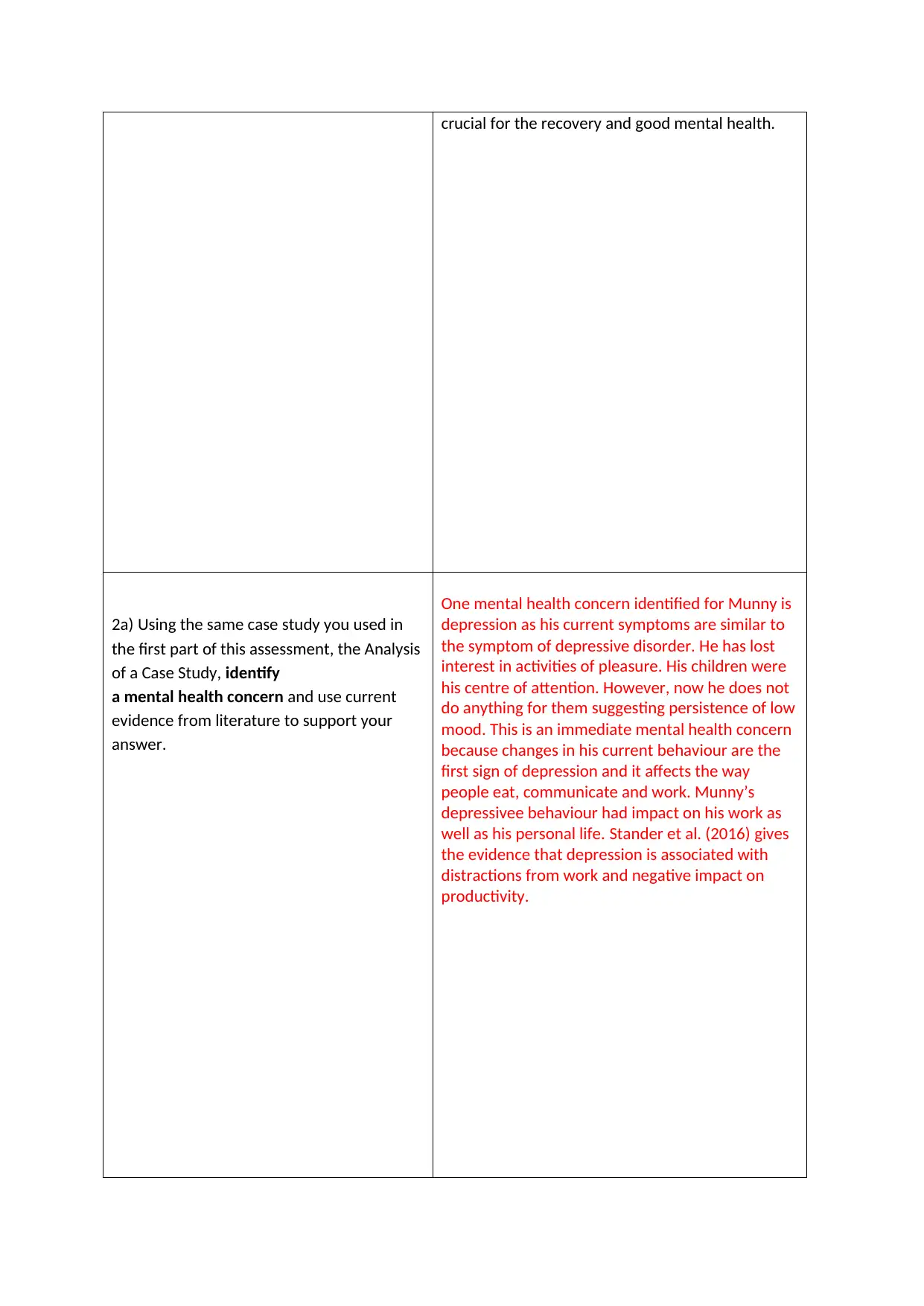
crucial for the recovery and good mental health.
2a) Using the same case study you used in
the first part of this assessment, the Analysis
of a Case Study, identify
a mental health concern and use current
evidence from literature to support your
answer.
One mental health concern identified for Munny is
depression as his current symptoms are similar to
the symptom of depressive disorder. He has lost
interest in activities of pleasure. His children were
his centre of attention. However, now he does not
do anything for them suggesting persistence of low
mood. This is an immediate mental health concern
because changes in his current behaviour are the
first sign of depression and it affects the way
people eat, communicate and work. Munny’s
depressivee behaviour had impact on his work as
well as his personal life. Stander et al. (2016) gives
the evidence that depression is associated with
distractions from work and negative impact on
productivity.
2a) Using the same case study you used in
the first part of this assessment, the Analysis
of a Case Study, identify
a mental health concern and use current
evidence from literature to support your
answer.
One mental health concern identified for Munny is
depression as his current symptoms are similar to
the symptom of depressive disorder. He has lost
interest in activities of pleasure. His children were
his centre of attention. However, now he does not
do anything for them suggesting persistence of low
mood. This is an immediate mental health concern
because changes in his current behaviour are the
first sign of depression and it affects the way
people eat, communicate and work. Munny’s
depressivee behaviour had impact on his work as
well as his personal life. Stander et al. (2016) gives
the evidence that depression is associated with
distractions from work and negative impact on
productivity.
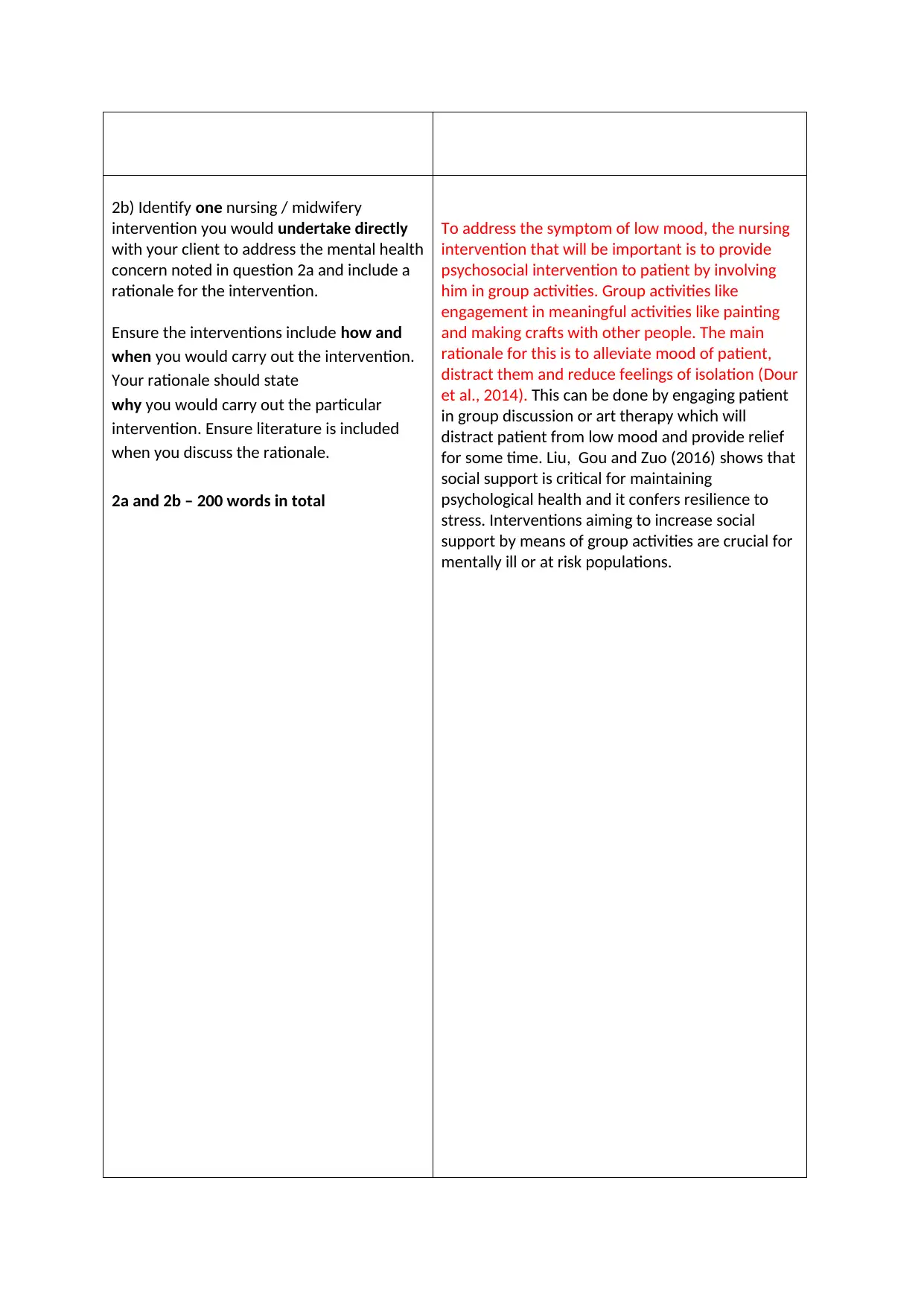
2b) Identify one nursing / midwifery
intervention you would undertake directly
with your client to address the mental health
concern noted in question 2a and include a
rationale for the intervention.
Ensure the interventions include how and
when you would carry out the intervention.
Your rationale should state
why you would carry out the particular
intervention. Ensure literature is included
when you discuss the rationale.
2a and 2b – 200 words in total
To address the symptom of low mood, the nursing
intervention that will be important is to provide
psychosocial intervention to patient by involving
him in group activities. Group activities like
engagement in meaningful activities like painting
and making crafts with other people. The main
rationale for this is to alleviate mood of patient,
distract them and reduce feelings of isolation (Dour
et al., 2014). This can be done by engaging patient
in group discussion or art therapy which will
distract patient from low mood and provide relief
for some time. Liu, Gou and Zuo (2016) shows that
social support is critical for maintaining
psychological health and it confers resilience to
stress. Interventions aiming to increase social
support by means of group activities are crucial for
mentally ill or at risk populations.
intervention you would undertake directly
with your client to address the mental health
concern noted in question 2a and include a
rationale for the intervention.
Ensure the interventions include how and
when you would carry out the intervention.
Your rationale should state
why you would carry out the particular
intervention. Ensure literature is included
when you discuss the rationale.
2a and 2b – 200 words in total
To address the symptom of low mood, the nursing
intervention that will be important is to provide
psychosocial intervention to patient by involving
him in group activities. Group activities like
engagement in meaningful activities like painting
and making crafts with other people. The main
rationale for this is to alleviate mood of patient,
distract them and reduce feelings of isolation (Dour
et al., 2014). This can be done by engaging patient
in group discussion or art therapy which will
distract patient from low mood and provide relief
for some time. Liu, Gou and Zuo (2016) shows that
social support is critical for maintaining
psychological health and it confers resilience to
stress. Interventions aiming to increase social
support by means of group activities are crucial for
mentally ill or at risk populations.
⊘ This is a preview!⊘
Do you want full access?
Subscribe today to unlock all pages.

Trusted by 1+ million students worldwide
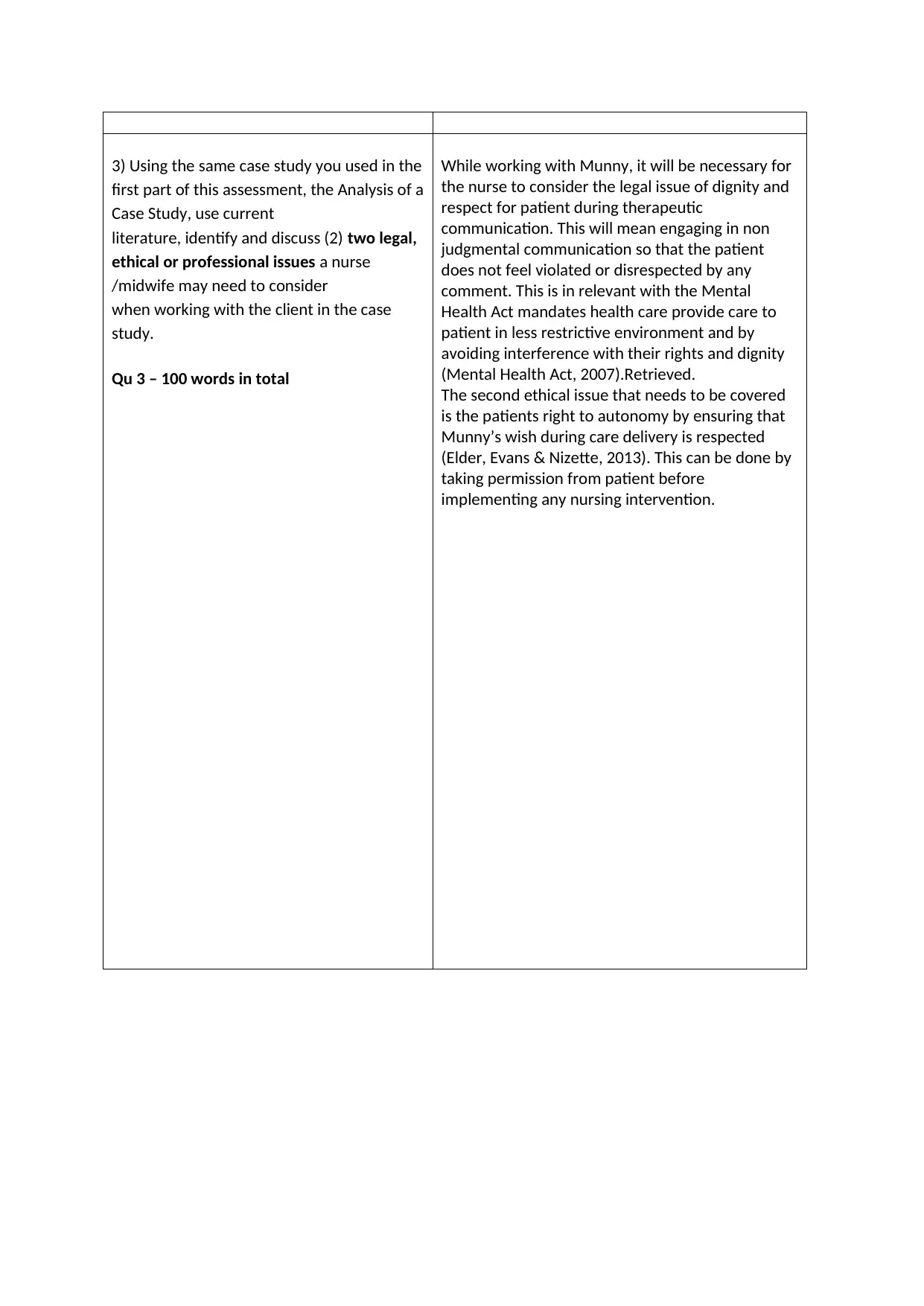
3) Using the same case study you used in the
first part of this assessment, the Analysis of a
Case Study, use current
literature, identify and discuss (2) two legal,
ethical or professional issues a nurse
/midwife may need to consider
when working with the client in the case
study.
Qu 3 – 100 words in total
While working with Munny, it will be necessary for
the nurse to consider the legal issue of dignity and
respect for patient during therapeutic
communication. This will mean engaging in non
judgmental communication so that the patient
does not feel violated or disrespected by any
comment. This is in relevant with the Mental
Health Act mandates health care provide care to
patient in less restrictive environment and by
avoiding interference with their rights and dignity
(Mental Health Act, 2007).Retrieved.
The second ethical issue that needs to be covered
is the patients right to autonomy by ensuring that
Munny’s wish during care delivery is respected
(Elder, Evans & Nizette, 2013). This can be done by
taking permission from patient before
implementing any nursing intervention.
first part of this assessment, the Analysis of a
Case Study, use current
literature, identify and discuss (2) two legal,
ethical or professional issues a nurse
/midwife may need to consider
when working with the client in the case
study.
Qu 3 – 100 words in total
While working with Munny, it will be necessary for
the nurse to consider the legal issue of dignity and
respect for patient during therapeutic
communication. This will mean engaging in non
judgmental communication so that the patient
does not feel violated or disrespected by any
comment. This is in relevant with the Mental
Health Act mandates health care provide care to
patient in less restrictive environment and by
avoiding interference with their rights and dignity
(Mental Health Act, 2007).Retrieved.
The second ethical issue that needs to be covered
is the patients right to autonomy by ensuring that
Munny’s wish during care delivery is respected
(Elder, Evans & Nizette, 2013). This can be done by
taking permission from patient before
implementing any nursing intervention.
Paraphrase This Document
Need a fresh take? Get an instant paraphrase of this document with our AI Paraphraser
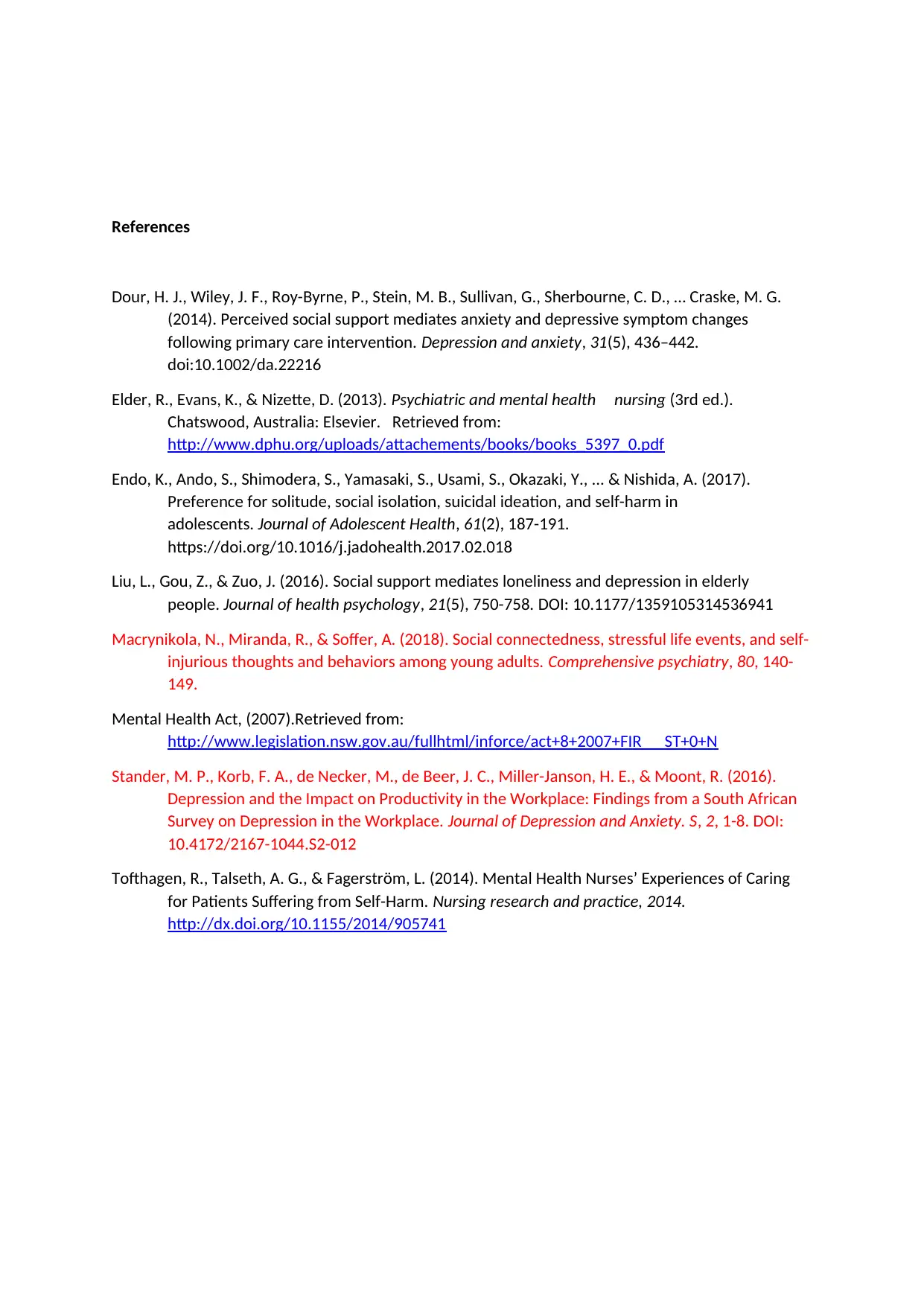
References
Dour, H. J., Wiley, J. F., Roy-Byrne, P., Stein, M. B., Sullivan, G., Sherbourne, C. D., … Craske, M. G.
(2014). Perceived social support mediates anxiety and depressive symptom changes
following primary care intervention. Depression and anxiety, 31(5), 436–442.
doi:10.1002/da.22216
Elder, R., Evans, K., & Nizette, D. (2013). Psychiatric and mental health nursing (3rd ed.).
Chatswood, Australia: Elsevier. Retrieved from:
http://www.dphu.org/uploads/attachements/books/books_5397_0.pdf
Endo, K., Ando, S., Shimodera, S., Yamasaki, S., Usami, S., Okazaki, Y., ... & Nishida, A. (2017).
Preference for solitude, social isolation, suicidal ideation, and self-harm in
adolescents. Journal of Adolescent Health, 61(2), 187-191.
https://doi.org/10.1016/j.jadohealth.2017.02.018
Liu, L., Gou, Z., & Zuo, J. (2016). Social support mediates loneliness and depression in elderly
people. Journal of health psychology, 21(5), 750-758. DOI: 10.1177/1359105314536941
Macrynikola, N., Miranda, R., & Soffer, A. (2018). Social connectedness, stressful life events, and self-
injurious thoughts and behaviors among young adults. Comprehensive psychiatry, 80, 140-
149.
Mental Health Act, (2007).Retrieved from:
http://www.legislation.nsw.gov.au/fullhtml/inforce/act+8+2007+FIR ST+0+N
Stander, M. P., Korb, F. A., de Necker, M., de Beer, J. C., Miller-Janson, H. E., & Moont, R. (2016).
Depression and the Impact on Productivity in the Workplace: Findings from a South African
Survey on Depression in the Workplace. Journal of Depression and Anxiety. S, 2, 1-8. DOI:
10.4172/2167-1044.S2-012
Tofthagen, R., Talseth, A. G., & Fagerström, L. (2014). Mental Health Nurses’ Experiences of Caring
for Patients Suffering from Self-Harm. Nursing research and practice, 2014.
http://dx.doi.org/10.1155/2014/905741
Dour, H. J., Wiley, J. F., Roy-Byrne, P., Stein, M. B., Sullivan, G., Sherbourne, C. D., … Craske, M. G.
(2014). Perceived social support mediates anxiety and depressive symptom changes
following primary care intervention. Depression and anxiety, 31(5), 436–442.
doi:10.1002/da.22216
Elder, R., Evans, K., & Nizette, D. (2013). Psychiatric and mental health nursing (3rd ed.).
Chatswood, Australia: Elsevier. Retrieved from:
http://www.dphu.org/uploads/attachements/books/books_5397_0.pdf
Endo, K., Ando, S., Shimodera, S., Yamasaki, S., Usami, S., Okazaki, Y., ... & Nishida, A. (2017).
Preference for solitude, social isolation, suicidal ideation, and self-harm in
adolescents. Journal of Adolescent Health, 61(2), 187-191.
https://doi.org/10.1016/j.jadohealth.2017.02.018
Liu, L., Gou, Z., & Zuo, J. (2016). Social support mediates loneliness and depression in elderly
people. Journal of health psychology, 21(5), 750-758. DOI: 10.1177/1359105314536941
Macrynikola, N., Miranda, R., & Soffer, A. (2018). Social connectedness, stressful life events, and self-
injurious thoughts and behaviors among young adults. Comprehensive psychiatry, 80, 140-
149.
Mental Health Act, (2007).Retrieved from:
http://www.legislation.nsw.gov.au/fullhtml/inforce/act+8+2007+FIR ST+0+N
Stander, M. P., Korb, F. A., de Necker, M., de Beer, J. C., Miller-Janson, H. E., & Moont, R. (2016).
Depression and the Impact on Productivity in the Workplace: Findings from a South African
Survey on Depression in the Workplace. Journal of Depression and Anxiety. S, 2, 1-8. DOI:
10.4172/2167-1044.S2-012
Tofthagen, R., Talseth, A. G., & Fagerström, L. (2014). Mental Health Nurses’ Experiences of Caring
for Patients Suffering from Self-Harm. Nursing research and practice, 2014.
http://dx.doi.org/10.1155/2014/905741
1 out of 5
Related Documents
Your All-in-One AI-Powered Toolkit for Academic Success.
+13062052269
info@desklib.com
Available 24*7 on WhatsApp / Email
![[object Object]](/_next/static/media/star-bottom.7253800d.svg)
Unlock your academic potential
Copyright © 2020–2025 A2Z Services. All Rights Reserved. Developed and managed by ZUCOL.





